Flying on one engine
By Colin Twiggs
March 10, 2016 6:30 p.m. AEDT (2:30 a.m. EST)
Advice herein is provided for the general information of readers and does not have regard to any particular person's investment objectives, financial situation or needs. Accordingly, no reader should act on the basis of any information contained herein without first having consulted a suitably qualified financial advisor.
Market direction is dominated at present by wild swings in the price of crude oil and other commodities (iron ore in Australia).
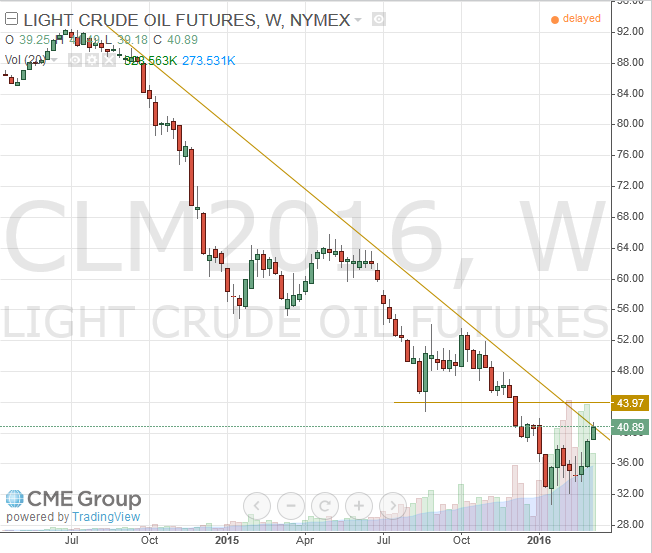
The rally (WTI Light Crude June 2016 futures) may run as high as $44/barrel before retracing to test support. Primary support sits at $30 and a higher trough, following breach of the descending trendline, would suggest that a bottom is forming. But that is far from definite as Patrick Chovanec at Silvercrest points out:
....so far this year stock market sentiment has taken many of its cues from the price of oil. On any given day, if you knew which way oil prices moved, you probably could tell which way the stock market moved. While we believe this linkage fails to recognize the critical distinctions we have so often highlighted, it can't be ignored in anticipating future market movements, at least in the near-term. The recent firming of oil prices reflects some important developments. After more than a year, we are finally seeing the initial signs of capitulation on the supply side: U.S. oil output has topped out and the most vulnerable OPEC members are agitating for cutbacks. Nevertheless, accumulated crude oil inventories remain at record high levels, which makes us wary concluding that the oil market has reached a hard bottom. While we think the oil price, and the producer industry, will gradually recover, we also think "consensus" expectations of a dramatic +20% gain in S&P 500 operating earnings this year, driven by a large and sudden rebound in the energy and materials sectors, continue to be overly optimistic. With this in mind, we are likely to see more sentiment-driven volatility in U.S. stock prices ahead, even as the U.S. economy continues on its path of slow growth.
Global
Dow Jones Global Index is testing resistance at 300. Respect is likely and reversal below 290 would warn of another decline. 13-Week Twiggs Momentum continues to flag a strong primary down-trend. Breach of 270 would confirm. Penetration of the descending trendline is unlikely but would warn that the down-trend is losing momentum and a bottom is forming.
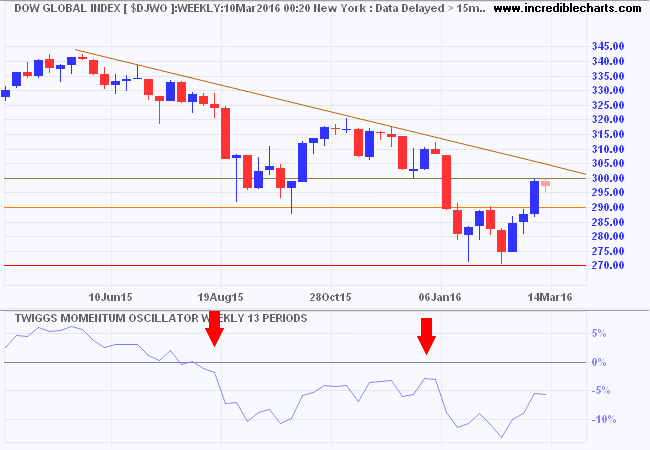
* Target calculation: 270 - ( 300 - 270 ) = 240
North America
"When you fly in a twin-engined aircraft and one engine cuts out, take comfort that the other engine will carry you to the scene of the crash."
Whenever I see the market index gradually rolling over in a broad topping pattern I am reminded of this saying by my Irish friend Ollie Flynn (who did a lot of flying in light aircraft to remote locations). When there is no sudden shock, like Lehman Brothers' collapse or LTCM, the market can remain undecided for a considerable time before rolling over into a hard down-trend.
The monthly chart of the S&P 500 is flying on one engine. Currently testing resistance at 2000, a peak at this level would strengthen the warning of a bear market. But even a peak at 2100 would keep the weight on the sell side. Follow-through below 1850 would confirm another decline. Rising 13-week Twiggs Money Flow indicates medium-term buying pressure but the overall trend is down.
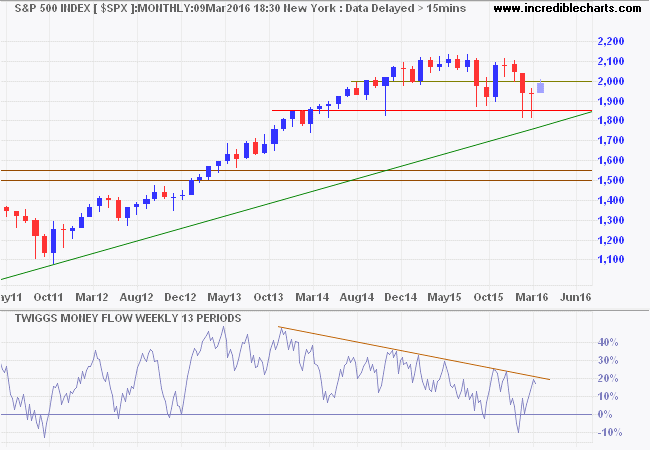
* Target calculation: 1900 - ( 2100 - 1900 ) = 1700
CBOE Volatility Index (VIX) below 20, suggests that (short-term) market risk is easing. Respect of this level (on the next spike) would strengthen the signal.
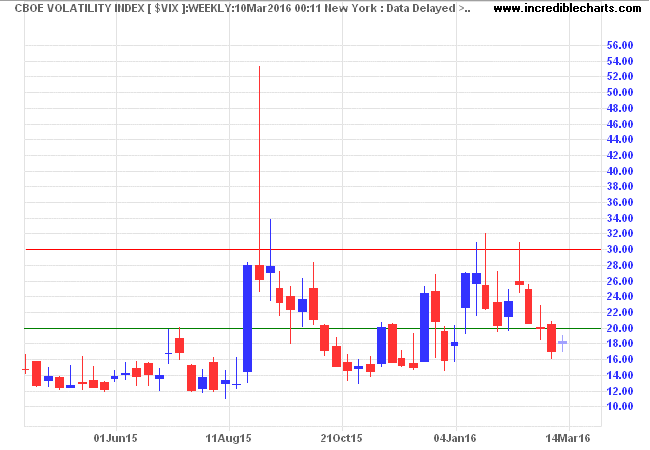
Canada's TSX 60 penetrated the descending trendline after breaking resistance at 750, suggesting that a bottom is forming. Expect stubborn resistance at 800. Rising 13-week Twiggs Momentum is so far indicative of a secondary rally rather than reversal of the primary down-trend. Depth of the next trough will provide a better indication as to the likelihood of a reversal.
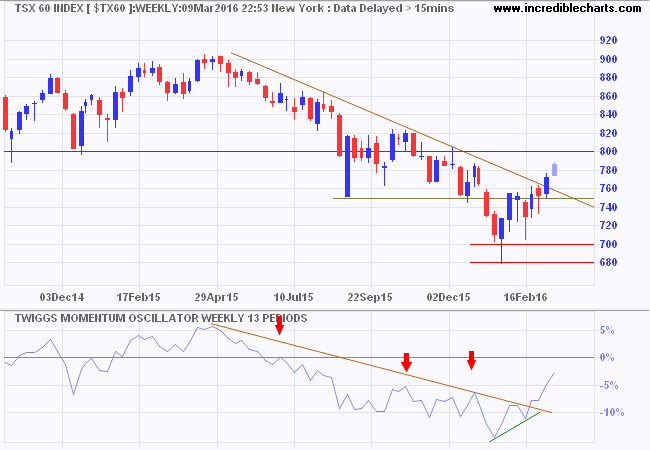
* Target calculation: 700 - ( 750 - 700 ) = 650
Europe
Dow Jones Euro Stoxx 50 found resistance at 3050 but bullish divergence on 13-week Twiggs Money Flow suggests that a test of 3300 is likely. The primary trend remains down and a lower peak, followed by reversal below 3000, would warn of a decline to 2500*.
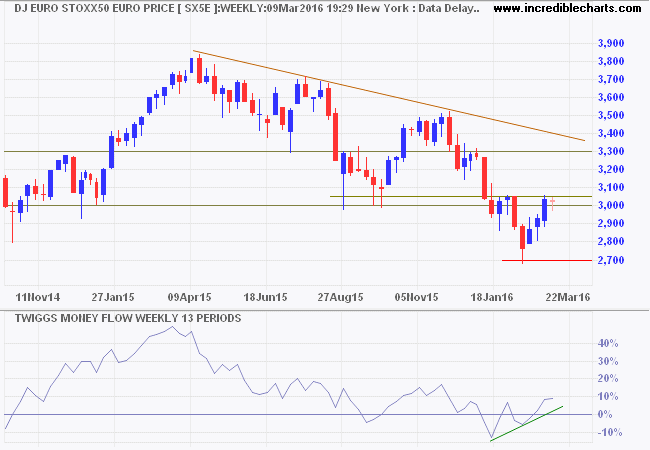
* Target calculation: 3000 - ( 3500 - 3000 ) = 2500
Germany's DAX displays a similar pattern, testing resistance at 10000. Breakout would indicate an advance to 11000. Buying pressure on 13-week Twiggs Money Flow appears secondary and reversal below 9300 would warn of another decline.
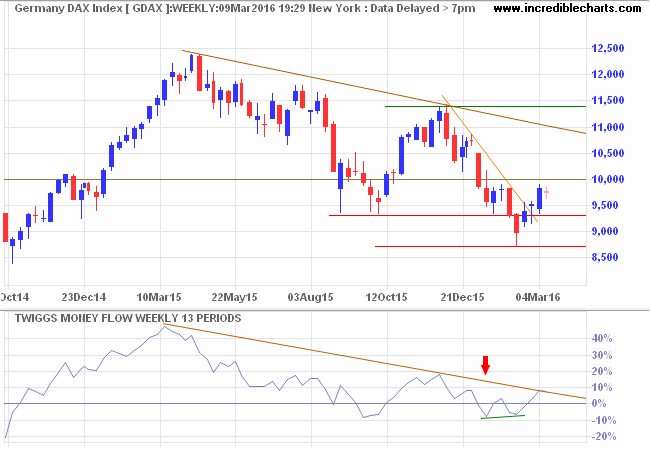
* Target calculation: 9500 - ( 11000 - 9500 ) = 8000
The Footsie found resistance at 6250, but this may be short-term and we can only expect committed resistance at 6500. Reversal below 6000 is unlikely at present, but would warn of another test of 5500. Breach of the descending trendline suggests that a bottom is forming. A higher trough would favor a reversal. While a trough above zero on 13-week Twiggs Money Flow would strengthen the signal.
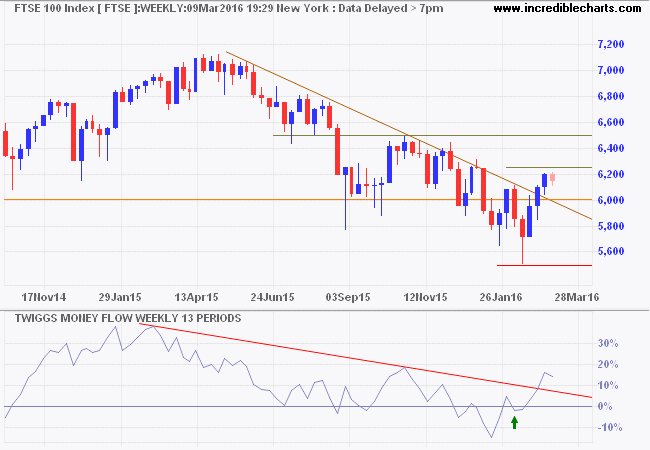
* Target calculation: 6000 - ( 6500 - 6000 ) = 5500
Asia
The Shanghai Composite Index continues to test support at 2700, with no indication of the recent excitement in iron ore markets. The primary trend is down and likely to remain so.
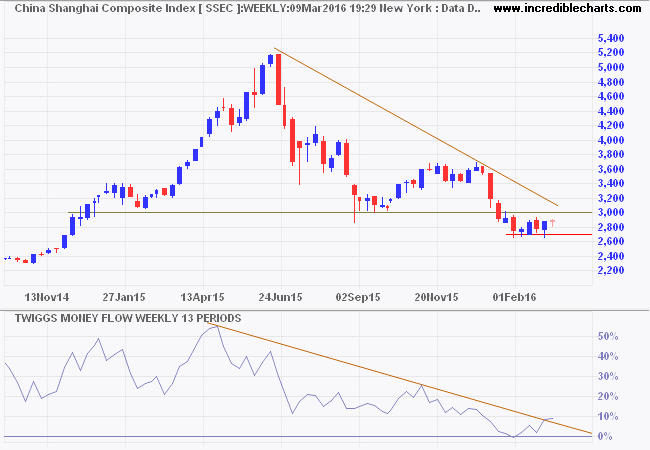
* Target calculation: 3000 - ( 3600 - 3000 ) = 2400
Japan's Nikkei 225 Index found resistance at 17000. Respect would warn of another test of 15000, while breakout would be likely to encounter stubborn resistance at 18000. 13-Week Twiggs Money Flow holding above zero is encouraging but I expect the primary down-trend is far from over.
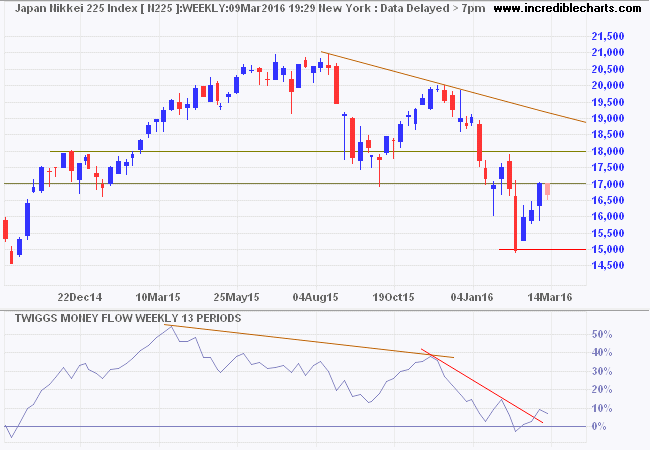
* Target calculation: 17000 - ( 20000 - 17500 ) = 15000
India's Sensex is testing resistance at 25000. Rising 13-week Twiggs Money Flow reflects strong (medium-term) buying pressure. Breakout is likely and would test the upper trend channel at 26000. Respect of the trend channel remains likely and would warn of another test of 22500*.
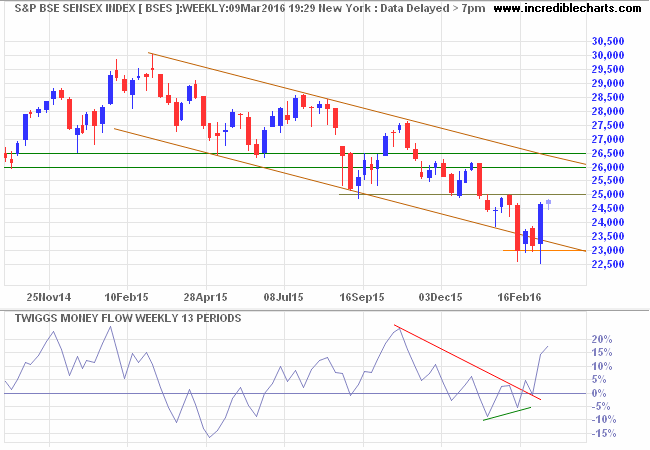
* Target calculation: 25000 - ( 27500 - 25000 ) = 22500
Australia
The ASX 200 is testing resistance at 5150, with rising 13-week Twiggs Money Flow indicating (medium-term) buying pressure. This is a bear market and respect of the descending trendline is likely, warning of another decline. Reversal below 5000 would warn of another test of 4700, while breach of 4700 would offer a target of 4400*.
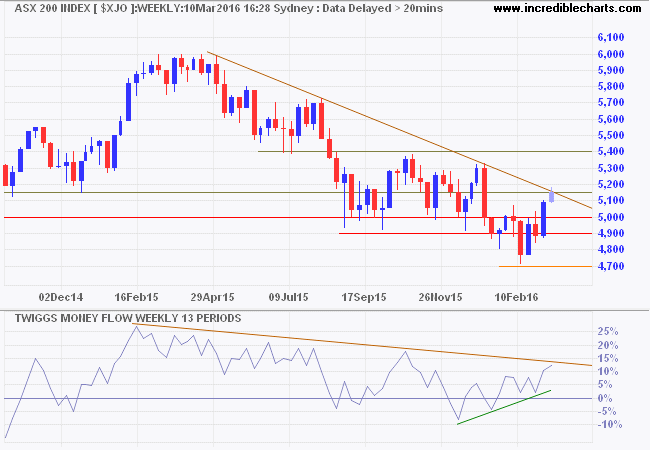
* Target calculation: 4800 - ( 5200 - 4800 ) = 4400
It never was my thinking that made the big money for me. It always was my sitting. Got that? My sitting tight! It is no trick at all to be right on the market. You always find lots of early bulls in bull markets and early bears in bear markets. I've known many men who were right at exactly the right time, and began buying or selling stocks when prices were at the very level which should show the greatest profit. And their experience invariably matched mine—that is, they made no real money out of it. Men who can both be right and sit tight are uncommon.
~ Jesse Livermore
Disclaimer
Porter Private Clients Pty Ltd, trading as Research & Investment ("R&I"), is a Corporate Authorized Representative (AR Number 384 397) of Andika Pty Ltd which holds an Australian Financial Services Licence (AFSL 297069).
The information on this web site and in the newsletters is general in nature and does not consider your personal circumstances. Please contact your professional financial adviser for advice tailored to your needs.
R&I has made every effort to ensure the reliability of the views and recommendations expressed in the reports published on its websites and newsletters. Our research is based upon information known to us or which was obtained from sources which we believe to be reliable and accurate.
No guarantee as to the capital value of investments, nor future returns are made by R&I. Neither R&I nor its employees make any representation, warranty or guarantee that the information provided is complete, accurate, current or reliable.
You are under no obligation to use these services and should always compare financial services/products to find one which best meets your personal objectives, financial situation or needs.
To the extent permitted by law, R&I and its employees, agents and authorised representatives exclude all liability for any loss or damage (including indirect, special or consequential loss or damage) arising from the use of, or reliance on, any information. If the law prohibits the exclusion of such liability, such liability shall be limited, to the extent permitted by law, to the resupply of the said information or the cost of the said resupply.
Important Warning About Simulated Results
Research & Investment (R&I) specialise in developing, testing and researching investment strategies and systems. Within the R&I web site and newsletters, you will find information about investment strategies and their performance. It is important that you understand that results from R&I research are simulated and not actual results.
No representation is made that any investor will or is likely to achieve profits or losses similar to those shown.
Simulated performance results are generally prepared with the benefit of hindsight and do not involve financial risk. No modeling can completely account for the impact of financial risk in actual investment. Account size, brokerage and slippage may also diverge from simulated results. Numerous other factors related to the markets in general or to the implementation of any specific investment system cannot be fully accounted for in the preparation of simulated performance results and may adversely affect actual investment results.
To the extent permitted by law, R&I and its employees, agents and authorised representatives exclude all liability for any loss or damage (including indirect, special or consequential loss or damage) arising from the use of, or reliance on, any information offered by R&I whether or not caused by any negligent act or omission.

Author: Colin Twiggs is a former investment banker with almost 40 years of experience in financial markets. He co-founded Incredible Charts and writes the popular Trading Diary and Patient Investor newsletters.
Using a top-down approach, Colin identifies key macro trends in the global economy before evaluating selected opportunities using a combination of fundamental and technical analysis.
Focusing on interest rates and financial market liquidity as primary drivers of the economic cycle, he warned of the 2008/2009 and 2020 bear markets well ahead of actual events.
He founded PVT Capital (AFSL No. 546090) in May 2023, which offers investment strategy and advice to wholesale clients.
